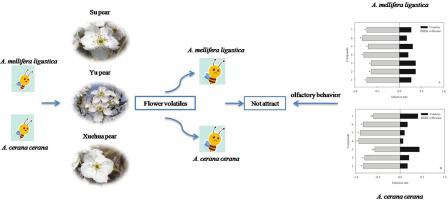Journal of Asia-Pacific Entomology ( IF 1.1 ) Pub Date : 2020-12-30 , DOI: 10.1016/j.aspen.2020.12.011 Weihua Ma , Denglong Long , Yi Wang , Xinyu Li , Jiaxing Huang , Jinshan Shen , Wenting Su , Yusuo Jiang , Jie Li

|
Honeybee pollination behavior is influenced by flower volatiles, which honeybees sense via olfactory receptors. Honeybees are only weakly attracted to pear flowers. To investigate the potential reasons, we extracted and determined the floral volatile compounds from three pear cultivars (Su, Ya, and Xuehua) using headspace solid-phase micro-extraction (HS-SPME) and gas chromatography-mass spectrometry (GC–MS). The effects of pear flower volatiles on the Asian honeybee (Apis cerana cerana Fabricius) and the European honeybee (Apis mellifera ligustica Spinola) were determined by electroantennogram (EAG) assays and behavioral tests in a three-arm olfactometer. Among the 76 flower volatiles detected with GC–MS, 21 were found in all three pear cultivars, accounting for approximately 70% of the total volatile content. 3-Methyl-1-butanol and (+)-limonene volatiles had the highest relative content. Five compounds elicited strong EAG responses in both bee species: 2-methylbutyraldehyde, 1-nonanal, 6-methyl-5-hepten-2-one, 3-methyl-1-butanol, and (+)-limonene. Neither bee species showed positive taxis to these volatiles. In behavioral tests, A. mellifera ligustica showed a low preference for 6-methyl-5-hepten-2-one (20%, 400 µg/µL) and 2-phenethyl alcohol (16.7%, 400 µg/µL). Apis cerana cerana showed a low preference for 6-methyl-5-hepten-2-one (6.7%, 400 µg/µL) and 1-nonanal (10%, 400 µg/µL), whereas its preferences for 3-methyl-1-butanol (43.3%, 400 µg/µL) and α-farnesene (40%, 400 µg/µL) were similar to that for the control. Therefore, a lack of attractive volatile compounds could explain why honeybees are only weakly attracted to pear flowers. Therefore, to achieve acceptable pollination in pear orchards, we suggest using flower-scent sugar syrup feeding and a saturation pollination strategy.
中文翻译:

亚洲和欧洲蜜蜂对梨花挥发物的电生理和行为响应
蜜蜂的授粉行为受花朵挥发物的影响,蜜蜂通过嗅觉感受器感知到。蜜蜂只被梨花吸引。为了研究潜在的原因,我们使用顶空固相微萃取(HS-SPME)和气相色谱-质谱(GC-MS)从三个梨品种(Su,Ya和Xuehua)中提取并测定了花香挥发性化合物。 。梨花挥发物对亚洲蜜蜂(Apis cerana cerana Fabricius)和欧洲蜜蜂(Apis mellifera ligustica)的影响斯皮诺拉(Spinola)通过三臂嗅觉计上的心电图(EAG)测定和行为测试确定。用GC-MS检测到的76种花卉挥发物中,在所有三个梨品种中均发现了21种,约占总挥发物含量的70%。3-甲基-1-丁醇和(+)-柠檬烯挥发物的相对含量最高。在这两种蜜蜂中,有五种化合物引起强烈的EAG响应:2-甲基丁醛,1-壬醛,6-甲基-5-庚-2-酮,3-甲基-1-丁醇和(+)-柠檬烯。两种蜜蜂均未显示出对这些挥发物呈阳性的滑移作用。在行为测试中,A。mellifera ligustica对6-甲基-5-庚二烯-2-酮(20%,400 µg / µL)和2-苯乙醇(16.7%,400 µg / µL)表现出较低的偏爱。中华蜜蜂对6-甲基-5-庚二酮(6.7%,400 µg / µL)和1-壬醛(10%,400 µg / µL)偏低,而对3-甲基-1-丁醇偏爱(43.3%,400 µg / µL)和α-法呢烯(40%,400 µg / µL)与对照相似。因此,缺乏有吸引力的挥发性化合物可以解释为什么蜜蜂只被梨花吸引得很弱。因此,为了达到梨园可接受的授粉,我们建议使用花香糖浆喂养和饱和授粉策略。









































 京公网安备 11010802027423号
京公网安备 11010802027423号